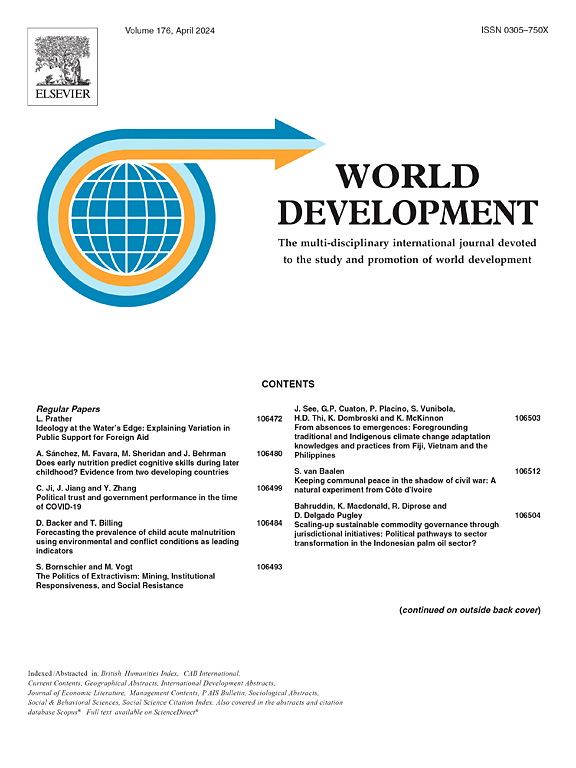India’s premature deindustrialization and Falling investment rate in the 2010s
IF 5.4
1区 经济学
Q1 DEVELOPMENT STUDIES
引用次数: 0
Abstract
India’s GDP growth rate faltered in the 2010s after steadily accelerating for decades since the early 1980s. The slowdown adversely affected employment growth, poverty reduction, and nutritional status. Why did it happen? As the study demonstrates, the answer is India’s premature deindustrialization and rising import dependence on China. Capital and intermediate goods industries got hollowed out, with the manufacturing GDP share stagnating at around 15-17 percent since 1991; annual industrial growth rates have declined steeply since 2015-16, even ignoring the Pandemic years. Manufacturing employment share has declined; agriculture’s share rose in the 2010s—an unmistakable sign of premature deindustrialization.
Why did industrial capacity get depleted relative to increasing consumption? The answer is an unprecedented decline in fixed investment and savings as shares of GDP. The share of fixed investment in industry and manufacturing declined significantly. The rising fixed investment share of services is driven by telecom, Government, and other services. Relatedly, net FDI inflow and domestic capital market mobilization, as proportions of GDP, have declined in the 2010s. Up to 70 percent of FDI went into brownfield investment, not greenfield investment. Policy efforts, namely, the Make in India and Atmanirbhar (self-reliant) Bharat initiative and production-linked incentives (PLI), have yet to yield measurable results.
India now needs an industrial policy to overcome premature deindustrialization, in the changed geopolitical context. It would help reverse the decline in industrial investments and target greenfield FDI and technology acquisition. The public sector must reimagine its entrepreneurial role in long-term strategic interests, as the private corporate investment rate is yet to pick up. Raising public investment while maintaining fiscal and external balances will require raising domestic saving rates. Term-lending institutions must boost the supply of long-term credit at low and stable interest rates. The stagnant domestic R&D investment rate must rise quickly to catch up with China.
2010年代印度过早的去工业化和投资率下降
自上世纪80年代初以来,印度的GDP增长率在经历了数十年的稳步增长后,在2010年代出现了下滑。经济放缓对就业增长、减贫和营养状况产生了不利影响。为什么会这样呢?正如研究表明的那样,答案是印度过早的去工业化和对中国进口的日益依赖。资本和中间产品行业被掏空,制造业占GDP的比重自1991年以来一直停滞在15- 17%左右;自2015-16年以来,即使不考虑大流行年份,年度工业增长率也急剧下降。制造业就业份额下降;农业所占份额在2010年有所上升,这是过早去工业化的明显迹象。为什么工业产能相对于不断增长的消费变得枯竭?答案是固定投资和储蓄占GDP比重的空前下降。工业和制造业的固定资产投资比重大幅下降。电信、政府和其他服务推动了服务业固定投资份额的上升。与此相关的是,FDI净流入和国内资本市场动员占GDP的比例在2010年代有所下降。高达70%的外国直接投资进入了棕地投资,而不是绿地投资。政策努力,即“印度制造”和“自力更生的印度”倡议以及与生产相关的激励措施(PLI),尚未产生可衡量的结果。在改变了的地缘政治背景下,印度现在需要一项产业政策来克服过早的去工业化。这将有助于扭转工业投资下滑的趋势,并瞄准绿地FDI和技术收购。由于私人企业投资率尚未回升,公共部门必须从长期战略利益出发,重新设想自己的企业角色。在保持财政和外部平衡的同时增加公共投资,将需要提高国内储蓄率。定期贷款机构必须以稳定的低利率增加长期信贷供应。停滞不前的国内研发投资率必须迅速上升,才能赶上中国。
本文章由计算机程序翻译,如有差异,请以英文原文为准。
求助全文
约1分钟内获得全文
求助全文
来源期刊

World Development
Multiple-
CiteScore
12.70
自引率
5.80%
发文量
320
期刊介绍:
World Development is a multi-disciplinary monthly journal of development studies. It seeks to explore ways of improving standards of living, and the human condition generally, by examining potential solutions to problems such as: poverty, unemployment, malnutrition, disease, lack of shelter, environmental degradation, inadequate scientific and technological resources, trade and payments imbalances, international debt, gender and ethnic discrimination, militarism and civil conflict, and lack of popular participation in economic and political life. Contributions offer constructive ideas and analysis, and highlight the lessons to be learned from the experiences of different nations, societies, and economies.
 求助内容:
求助内容: 应助结果提醒方式:
应助结果提醒方式:


